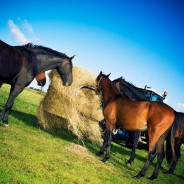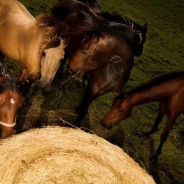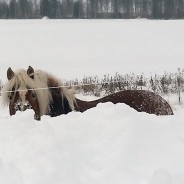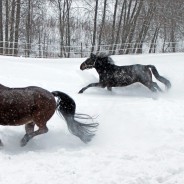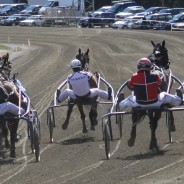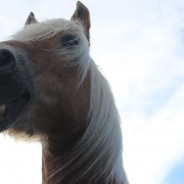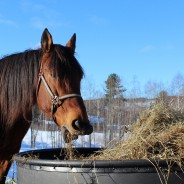The forage blog – all about forage for horses
Here AgrD Sara Muhonen blogs about feeding and forage for horses. If you have questions or suggestions on what we should discourse feel free to e-mail us via the contact page.
Forage crude protein concentration affects horses’ insulin response
Early harvested forage has high energy content but also often high crude protein content and it seems that the amount of crude protein (cp) in forage can affect horses’ insulin response after feeding. In this study 5 Standardbred trotters in training were fed forage with differing concentrations of sugar (30-120 g/kg dry matter (DM)) and protein (63-107 g digestible cp/kg DM). The feeding regimes resulted in one high daily cp intake of > 180 g cp/100 kg bodyweight (BW) (180 g cp = 138 g digestible cp) and one lower daily cp intake of ≤ 180...
read moreHow to use the ratio between protein and energy
In Sweden the horse’s energy requirement is given in metabolizable energy (ME), and the unit is mega joule (MJ). In other countries the horse’s energy requirement can be given in digestible energy (DE) or net energy (NE). Roughly DE × 0.86 = ME and ME × 0.74 = NE. The horse’s protein requirement can be given in relation to the energy requirement. In Sweden the ratio of gram digestible crude protein per MJ ME (g dCP/MJ ME) is used. Adult horses need at least 6 g dCP/MJ ME to fulfil the maintenance requirement of protein. If we for example buy...
read moreHorses are fantastic hindgut fermenters
This study compared different forage intakes using sedentary horses. Eight adult Icelandic horses were used and all horses were tested on forage intake of haylage for maintenance requirements and forage intake of haylage for maintenance requirements × 1.5. The forage was an early harvested grass haylage. The results show how digestibility for dry matter (DM), the fibre fractions NDF and ADF decreases when the horses are fed the higher forage intake, maintenance × 1.5 (Figure 1). The differences were 3.3% for DM, 6.5% for the fibre fraction...
read moreDifferent feeds have small impact on pH in horses’ oral cavity
In this study the pH in horses’ oral cavity was examined during feeding with different forages. pH is a measure of acidity and the lower the pH the more acid is the environment. The forages used was frozen fresh matter (> 30% DM), silage (60% DM), haylage (40% DM) and hay (> 82% DM) and they were harvested the same day from the same ley. The fresh matter was taken directly from the field after cutting and frozen. The pH values of the forages were 6.44 for fresh matter, 5.83 for silage, 6.18 for haylage and 6.85 for hay. Four...
read more“Rebale” into small bales
Silage or haylage in big bales can be problematic for smaller horse farms. The big bales contain too much forage for a few horses to finish in 3-4 days and big bales cannot be moved manually. Therefore small bales are often requested when they are easier to handle. Small bales of silage or haylage are produced in mainly two ways: by using small round balers or conventional high-density square balers used for haymaking at harvest, or by harvesting the forage in large round bales which are later opened during winter and “rebaled” into small...
read moreForage-only diet and road transport positive for exercise performance
This study examined how the impact of diet and road transport to competition may affect performance in Standardbred horses. A diet consisting of energy rich haylage was compared to a diet of 50:50 haylage:oats. The same haylage was used for the two diets and bots diets covered the maintenance requirements × 2 and were supplemented with minerals and salt. Race-like exercise tests on an oval racetrack were performed both with 100 km road transport and without road transport. The two diets implied no difference in body weight or BCS (body...
read moreThe horse’s stomach – size, pH and gastrin
In adult horses the stomach volume comprises about 10% of the gastrointestinal tract. Horses are large grass eating animals, herbivores, adapted to eating grass which takes long time to gather, chew and swallow and a large stomach for storing of food is therefore not necessary. The horse’s stomach should never be completely empty, the digesta stays here about 2-6 hours and the stomach is emptied faster when horses eat forage than when they eat concentrate. In contrast to other monogastric animals the mucosal surface of the equine stomach is...
read moreMicrobiological hygiene analysis of forage
A microbiological hygiene analysis is often considered after a visual and oral examination has established that the forage is bad. The ambition of the microbiological hygiene analysis is often to try to determine if the forage can be fed or not. Often the best thing to do is to first call the laboratory and describe the problem and how the damaged forage looks/smells, and then one can get instructions on how/where to take samples and how they should be sent. Usually laboratories analysing nutrient content in forage also perform hygiene...
read moreEnhanced energy metabolism with only forage and no concentrate
A Swedish study used a method called proteomics to analyse metabolic changes in muscle in trotters in training when fed a forage-only diet compared to a 50:50 forage:concentrate diet. The forage-only diet consisted of early harvested energy rich haylage and the forage:concentrate diet consisted of late harvested haylage from the same ley. The concentrate consisted of mainly oats and soybean meal and both diets were supplemented with minerals and salt. The two diets, forage-only and forage:concentrate, provided the same daily energy and...
read moreHigher vitamin content with well ensiled forage
Good forage is the greatest source of natural vitamins and can often cover horses’ vitamin requirements. But the vitamin content of forage can vary a lot depending on where it is grown, plant species, harvest date, climate, conservation method etc. Silages often contain considerable more vitamins than for example hay and factors that can affect the vitamin loss in forage are weather conditions during wilting and storage time. A conservation study where silage and haylage from the same grass ley were wilted 4 h to 30% DM, 24 h to 50% DM and 34...
read more

